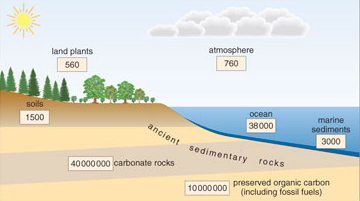4.1 Natural stores of carbon
The major natural stores of carbon (called 'reservoirs') are shown below in Figure 1.9.

Question 8
Which two reservoirs contain most of the carbon?
Answer
Carbonate rocks and preserved organic carbon.
Carbon is being exchanged continually between the principal reservoirs shown in Figure 1.9. However, since most stored carbon is held in carbonate rocks and preserved organic carbon (POC), the principal carbon exchange over geological timescales (millions of years) is from the surface reservoirs into limestones and POC.
For our purposes two exchange systems can be distinguished (somewhat artificially because in practice the two are intimately linked):
the land-based or terrestrial system in which carbon is exchanged between land plants and both the soil and the atmosphere;
the marine system which exchanges carbon within the oceans and between the oceans and the atmosphere.
Together they form the natural carbon cycle.
